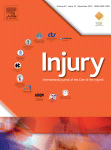Wound closure of leg fasciotomy: comparison of vacuum-assisted closure versus shoelace technique. A randomised study.
Kakagia D(1), Karadimas EJ(2) Drosos G(3), Ververidis A(3) Trypsiannis G(4), Verettas D(3)
1Department of Plastic and Reconstructive Surgery, Democritus University in Thrace Hospital, Alexandroupolis, Greece. Electronic address: despoinakakagia@yahoo.com.
2Department of Orthopedics, Democritus University in Thrace Hospital, Alexandroupolis, Greece; Department of Orthopedics, Hellenic Red Cross Hospital, Athens, Greece.
3Department of Orthopedics, Democritus University in Thrace Hospital, Alexandroupolis, Greece.
4Department of Medical Statistics, Democritus University in Thrace, Alexandroupolis, Greece.
Quality of Evidence : Level 2 Randomized Control Trial
Background: Fasciotomies are common procedures in high energy trauma practice. These increase morbidity, duration of hospital stay and expenditure. This study compared two methods of wound closure, Vaccum Assisted Closure Vs Shoelace technique.
MATERIALS AND METHODS:
- Population: 50 patients with leg fasciotomies (82 wounds) due to fractures and soft tissue injuries, who were randomly assigned to two groups. Fractures were treated with two incision fasciotomy whereas soft tissue Injuries were treated using single incision fasciotomy.
- Intervention: 25 patients underwent vacuum assisted closure(125 mm Hg) at 3-5 days following fasciotomy. (VAC, n=42 wounds, group V). Additional split skin grafting was required in patients with more than 5cm.
- Comparison: 25 patients underwent shoelace technique (n=40 wounds, group S). The technique described by Cohn and Berman was used, and the wound was closed using silastic vessel loops. Tightening was done on the bedside when edema subsided (3-6 days) and on a daily basis.
- Outcome measurements: Wound length, time to definite closure, complications, need for additional interventions and daily treatment costs were data collected and statistically assessed.
- Mean follow up: 21 months
RESULTS
- Wound closure time was significantly higher in group V(19.1 days) compared to group S (15.1 days)(p=0.001; 95% CI of the difference, 1.8–6.3 days).
- The closure time was more if fasciotomy was performed 8 hours after injury (V= 29 Vs S= 18.2 days)
- Five group V patients required split thickness skin grafts.
- In six group S patients, the vessel loops had to be replaced.
- Wound infection was seen in 6 VAC patients and 4 in the shoelace group
- The mean daily cost of negative pressure therapy alone was 135 euro (range 117–144 euro), whilst the mean daily cost of treatment for the shoelace technique was 14 euro ranging from 8 to 18 euro (p<0.001).
Conclusions
- Negative Pressure wound therapy and shoelace technique are safe, reliable and effective techniques for fasciotomy wound closure following trauma.
- VAC was associated with longer time to definite wound closure and is far more expensive than the shoelace technique, especially when additional skin grafting is required.
Ref:
1. http://www.injuryjournal.com/article/S0020-1383(12)00049-6/abstract
2. http://www.myorthoevidence.com/ace/6469/list/all
3. http://www.ncbi.nlm.nih.gov/pubmed/22377275

Leave a Reply